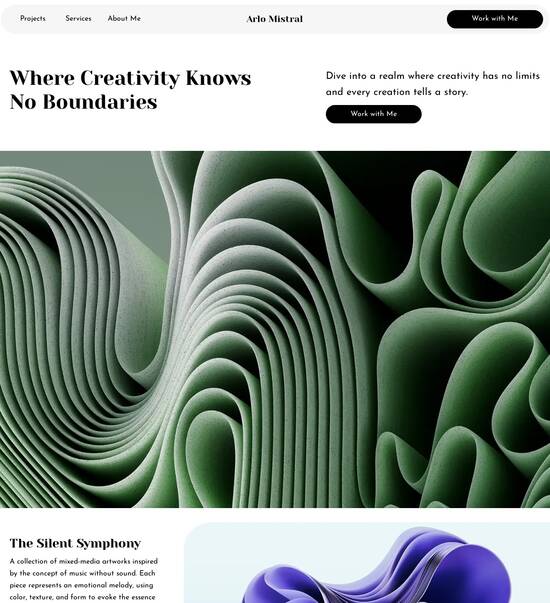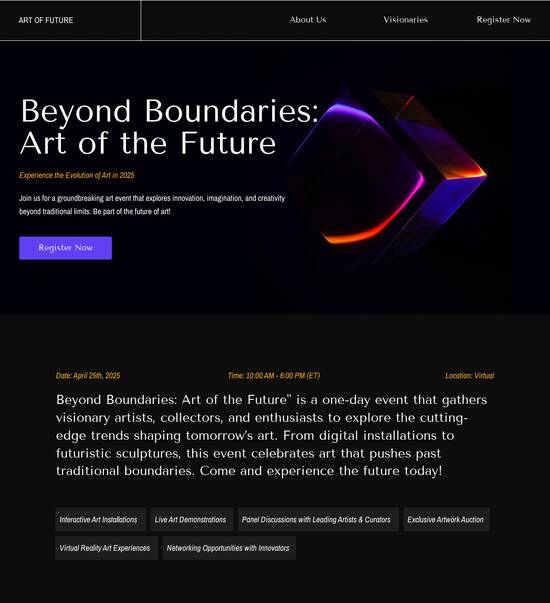
Modern heatmap page template
Explore Similar TemplatesAbout template
Unleash your creativity with the modern heatmap page template. Try Instapage today.
Recommended templates

Easy to build without coding
With the intuitive drag-and-drop builder, anyone on your team can create high-converting pages without any knowledge of code or design. Make enhancements to your landing page with custom widgets using Javascript, HTML/CSS, or third-party scripts.

Multiple layouts for any industry and goal
Select from 500+ landing page layouts built to boost conversions across industry-specific scenarios. Customize them by adjusting fonts, adding images, and generating on-brand content with the AI assistant. Quickly scale with Instablocks® and Global Blocks that you can save, reuse, and update globally.

Loads fast and looks polished on any device
Every template is responsive, which means they present professionally on any device and load blazingly fast with our Thor Render Engine. You can also power them up with Google AMP technology to deliver an unparalleled mobile experience and drive higher conversions.

Robust analytics & experimentation
Get real-time updates and reporting across all your devices, showing the number of visitors, conversions, cost-per-visitor, and cost-per-lead. Launch AI-powered experiments, run A/B tests, and use heatmaps to analyze user behavior, then optimize your landing page to maximize conversions.







Easy to build without coding
With the intuitive drag-and-drop builder, anyone on your team can create high-converting pages without any knowledge of code or design. Make enhancements to your landing page with custom widgets using Javascript, HTML/CSS, or third-party scripts.
Multiple layouts for any industry and goal
Select from 500+ landing page layouts built to boost conversions across industry-specific scenarios. Customize them by adjusting fonts, adding images, and generating on-brand content with the AI assistant. Quickly scale with Instablocks® and Global Blocks that you can save, reuse, and update globally.
Loads fast and looks polished on any device
Every template is responsive, which means they present professionally on any device and load blazingly fast with our Thor Render Engine.
Robust analytics & experimentation
Get real-time updates and reporting across all your devices, showing the number of visitors, conversions, cost-per-visitor, and cost-per-lead. Launch AI-powered experiments, run A/B tests, and use heatmaps to analyze user behavior, then optimize your landing page to maximize conversions.
All the features you need to build lead-generating landing pages
Explore more featuresLearn how to build top-performing landing pages for any goal
FAQs
Leading the way in building high-performing landing pages





Unlocking the Power of the Modern Heatmap Page Template with Instapage
Using a modern heatmap page template can revolutionize how marketers optimize their landing pages. Instapage provides tools that are essential for generating insights through detailed heatmaps, revealing where visitors click, scroll, and engage. This data is invaluable for refining your digital marketing strategies and maximizing ROI.
Understanding the Importance of a Modern Heatmap Page Template
A modern heatmap page template is crucial for marketers focused on conversion rate optimization (CRO). It allows for quick analysis of user behavior, facilitating adjustments to enhance performance. Here are three key benefits of utilizing heatmap technology:
- Enhanced visibility: Gain insights into user interactions on your landing pages, identifying hot spots that drive conversions.
- Data-driven decisions: Make informed adjustments based on actual user behavior rather than assumptions.
- Increased conversion rates: Optimize layout and content to align with user preferences, leading to better engagement.
Step 1: Choosing the Right Modern Heatmap Page Template
Selecting the appropriate template is foundational in utilizing heatmaps effectively. Consider the following tips:
- Identify your objectives: Determine whether your focus is lead generation, product sales, or brand awareness.
- Evaluate design flexibility: Ensure the template allows for easy customization to fit your branding and messaging.
- Check compatibility: Verify that the template integrates seamlessly with your existing tools and platforms.
Step 2: Implementing the Heatmap Tracking Mechanism
Once the template is chosen, the next step is to deploy heatmap tracking. Here’s how to proceed:
- Insert tracking code: Ensure you integrate the Instapage tracking code into your template to capture user interactions.
- Set your tracking parameters: Define what interactions to observe, such as clicks, scroll depth, and engagement time.
- Test functionality: Before launching, run a test to confirm that tracking is capturing data accurately.
Step 3: Analyzing Heatmap Data for Optimization
Analyzing the data collected through your heatmap tracking enables actionable insights. Focus on these areas:
- Review hotspots: Identify areas with high click rates and adjust corresponding content to amplify conversions.
- Pay attention to drop-off points: Investigate why users are leaving the page without converting, reshaping it to retain engagement.
- Utilize A/B testing: Use the heatmap insights to formulate A/B tests for different elements of your landing page.
By following these steps using a modern heatmap page template, you can significantly enhance your landing page performance.
Ready to unlock your landing page's potential? Start using Instapage’s powerful templates and heatmap tools today to drive better results!
People also ask about Modern heatmap page template
Modern heatmap page template: A guide to enhancing user experience
Revolutionizing data representation through modern heatmaps
Heatmaps have emerged as a crucial tool in today’s data-driven landscape, offering intuitive visual insights that enable better decision-making. They transform complex datasets into understandable representations by utilizing colors to convey levels of activity or engagement. This visualization not only simplifies data interpretation but also serves as a powerful method for optimizing user experience on websites.
Understanding users’ interactions more clearly.
Identifying design elements needing adjustment.
Increasing conversion rates by refining user pathways.
Understanding the basics: What is a heatmap?
At its core, a heatmap is a data visualization technique that employs color coding to represent values in a two-dimensional space. Originally used in fields like geography and meteorology, heatmaps have evolved to be indispensable in web analytics, marketing, and user experience design. As websites became more complex, the necessity to visualize user interactions grew, leading to the development of modern heatmaps.
The primary role of heatmaps in website analytics is to illustrate where users click, scroll, and hover the most, providing insights into behavior patterns. This information allows marketers and web designers to tailor their content and layout based on actual engagement, rather than relying on assumptions.
The power of visual data representation
Humans are inherently visual creatures, with the ability to process visual information far more swiftly and efficiently than text-based data. Research indicates that visuals attract up to 94% more views than text alone, emphasizing the necessity for marketers to incorporate tools like heatmaps into their websites. By creating a direct connection between data and visual representation, businesses can facilitate better understanding and retention of information.
Cognitive psychology supports the argument for visuals; heatmaps reduce cognitive load, allowing users to grasp trends and patterns quickly. This is particularly critical in a fast-paced digital environment where quick decision-making can lead to a significant competitive edge.
Features of modern heatmap page templates
Modern heatmap page templates offer a suite of features designed to provide readers and marketers with profound insights into user behavior. The intricacies of heatmap functionality encompass various types that cater to different analytical needs, including click maps, scroll maps, and hover maps. Each type serves a distinct purpose, allowing marketers to assess where users are most engaged versus where they drop off.
Click maps show where users are clicking on a page.
Scroll maps reveal how far users scroll down a page.
Hover maps track where users are hovering their mouse, indicating interest.
Furthermore, variations in data representation, such as usage statistics and user interaction data, provide a detailed view of how effectively content is engaging users, enabling marketers to utilize this knowledge for optimizing website performance.
Intricacies of heatmap functionality
Heatmaps can represent data in numerous ways, transforming raw numbers into easily actionable insights. For example, usage statistics can show page visits and time spent, while user interaction data indicates the effectiveness of specific elements or content pieces on a page. Such granularity allows for strategic adjustments that can significantly influence conversion rates.
Marketers can personalize the user experience further by incorporating advanced data metrics into their analysis. This data enables them to identify what draws users in and what doesn’t, a crucial step in fine-tuning marketing strategies.
Customization capabilities
One of the strongest selling points of modern heatmap page templates is their ability to be customized to meet specific business needs. Marketers can tailor their color schemes to evoke different psychological responses from users, leveraging the impact of colors on user perception and engagement. Selecting the appropriate color palette can highlight levels of engagement and direct attention effectively.
Warm colors like red and yellow indicate high engagement.
Cool colors like blue and green can signal calm or neutral areas.
Additionally, adjustable parameters allow marketers to hone in on tailored insights based on specific metrics and timeframes, making data analysis even more precise and relevant. This capacity for customization ensures that campaigns can be optimized in real time, aligning strategies with evolving user behaviors.
Heatmaps: A method for enhanced user experience
Interpreting user behavior through heatmaps can reveal valuable insights into how visitors engage with various elements of a website. For instance, analyzing user interactions with cart and product pages can provide invaluable information on the purchasing journey. Understanding scrolling behavior lends context to content engagement, allowing marketers to see which sections resonate most with users.
Identifying high-engagement areas can optimize content placement.
Noting disengaged regions can inform redesign efforts.
Key metrics derived from heatmap analysis can direct strategic decisions.
Key metrics derived from heatmap analysis include click-through rates, the effectiveness of call-to-action placements, and general user interaction levels, providing a roadmap for enhanced user experience strategies that resonate with visitors.
Implementing insights to optimize websites
The implementation of insights from heatmap analysis can dramatically optimize websites. Case studies demonstrate successful transformations driven by heatmap analysis, showcasing businesses that have reevaluated their user interface based on qualitative data. Identifying bottlenecks, high exits, and low engagement areas can be the catalyst for considerable improvements in a site's performance.
Improving navigation by simplifying design based on user feedback.
Incorporating engaging content in high-interest areas.
Retesting layouts based on ongoing heatmap data.
Best practices for utilizing heatmaps emphasize periodic reviews and adjustments, ensuring that websites remain aligned with user needs and preferences. Leveraging insights for continuous improvement not only enhances overall site performance but also fosters greater user trust and satisfaction.
Innovative applications of heatmaps in landing page optimization
Modern heatmap page templates are increasingly being applied innovatively in landing page optimization. Mapping user engagement reveals insights into how potential customers interact with landing pages, enabling marketers to refine content and layout strategically. Identifying actionable content areas becomes possible through a rigorous analysis of engagement patterns, allowing for significant enhancements to capture visitor interest.
Enhancing CTAs based on user clicks and interaction.
Highlighting key messages in sections with higher engagement.
Testing various visual elements that attract the most interactions.
Fine-tuning visual elements—such as buttons, images, and headers—based on user interaction allows marketers to craft high-performing landing pages, ultimately increasing conversion rates.
Heatmaps in A/B testing: A method for continuous improvement
Heatmaps serve as vital tools in A/B testing strategies, offering real-time insights that facilitate continuous improvement. By utilizing heatmaps, marketers can observe how users respond to different design variations, making necessary adjustments to enhance performance. For instance, comparing heatmaps from two different CTA buttons can reveal which design garners more engagement, allowing teams to pivot quickly.
Identifying the most effective design elements for optimized engagement.
Assessing real-time user behavior during tests.
Iterating designs based on recorded user preferences.
This capacity for evaluating design effectiveness using heatmaps ensures that marketers can incorporate user feedback dynamically, crafting pages that resonate profoundly with visitors. Such an iterative process is fundamental for continuous growth and optimization in digital marketing.
The future of heatmaps in web development
As technology advances, so does the functionality of heatmaps. Machine learning is poised to enhance heatmaps drastically, enabling predictive analytics that anticipate user behavior rather than simply reporting on it post-factum. This forward-thinking approach ensures that marketers can adapt strategies proactively based on trends.
Utilizing AI algorithms for intelligent data insights.
Real-time user behavior analysis for immediate adjustments.
Incorporating historical data to guide future modifications.
The relevance of heatmaps will only increase in e-commerce, where optimizing product pages with visual analytics can significantly enhance the online shopping journey. Understanding interactions on these pages allows for tailoring user experiences, driving conversions, and fostering brand loyalty.
Conclusion: The landscape of user-centric design with heatmaps
The integration of heatmaps into modern web design is a transformative step towards enhancing user experience. By summing up the impacts they have on design and decision-making, businesses can clearly see how these analytics guide improvements. Heatmaps not only enhance the usability of websites but also serve as indispensable tools in the broader context of data visualization, ensuring that every click and scroll offers actionable insights.
As marketers strive to create personalized and relevant experiences, leveraging heatmaps will remain at the forefront, facilitating continuous testing and optimization aligned with user behavior. Investing in modern heatmap page templates is not merely an option; it is essential for those aiming to stay competitive and increase engagement among target audiences.
Ready to skyrocket conversions?
Supercharge your ad campaigns with high-performing landing pages
Get started














